
Here’s my quarterly income update as a companion post to my April 2024 asset allocation & performance update. I prefer to track the income produced as an alternative metric to performance. The total income goes up much more gradually and consistently than the number shown on brokerage statements (market price), which helps encourage consistent investing. Here’s a related quote from Jack Bogle (source):
The true investor will do better if he forgets about the stock market and pays attention to his dividend returns and to the operating results of his companies. – Jack Bogle
Here is the historical growth of the S&P 500 total dividend, which tracks roughly the largest 500 stocks in the US, updated as of Q4 2023 (via Yardeni Research):
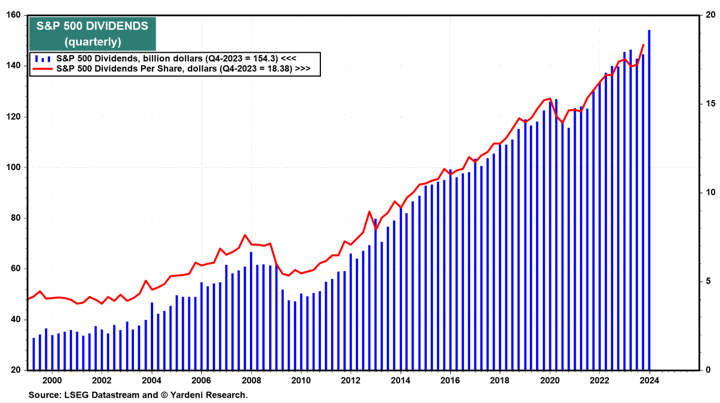
That is a much smoother ride than the price index. I imagine my portfolio as a factory that churns out dollar bills, or a tree that gives dividend fruit.
More details on dividends. Stock dividends are a portion of profits that businesses have decided to distribute directly to shareholders, as opposed to reinvesting into their business, paying back debt, or buying back shares. The dividends may suffer some short-term drops, but over the long run they have grown faster than inflation.
In the US, the dividend culture is somewhat conservative in that shareholders expect dividends to be stable and only go up. Thus the starting yield is lower, but grows more steadily with smaller cuts during hard times. Here is the historical growth of the trailing 12-month (ttm) dividend paid by the iShares Core S&P 500 ETF (IVV) via StockAnalysis.com. (They seem to have a data glitch at the moment with respect to VTI.)
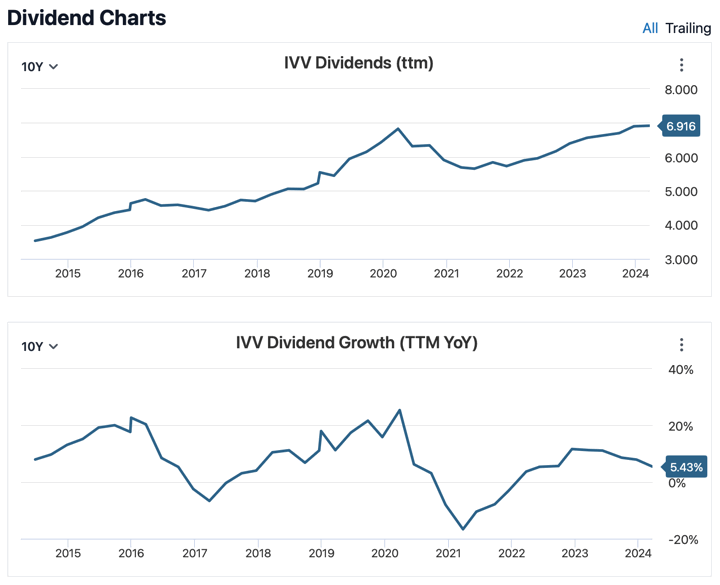
European corporate culture tends to encourage paying out a higher (sometimes fixed) percentage of earnings as dividends, but that also means the dividends move up and down with earnings. The starting yield is currently higher but may not grow as reliably. Here is the historical growth of the trailing 12-month (ttm) dividend paid by the Vanguard Total International Stock ETF (VXUS).
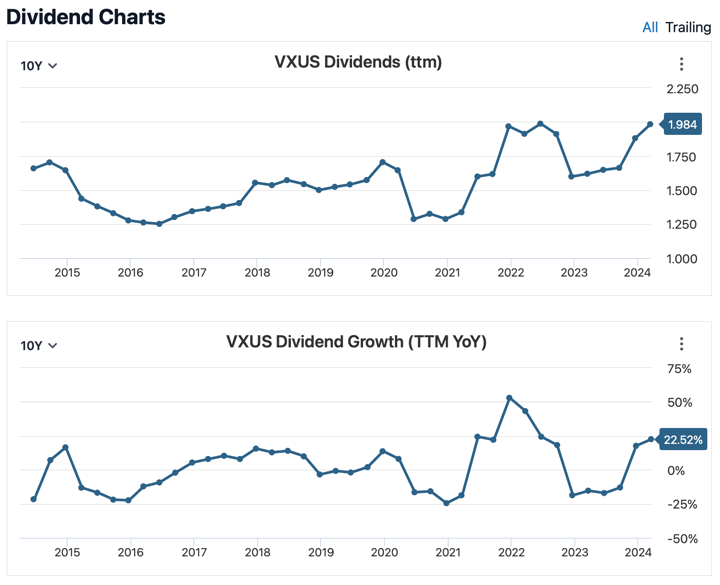
The dividend yield (dividends divided by price) also serve as a rough valuation metric. When stock prices drop, this percentage metric usually goes up – which makes me feel better in a bear market. When stock prices go up, this percentage metric usually goes down, which keeps me from getting too euphoric during a bull market.
My portfolio income history. I started tracking the income from my portfolio in 2014. Here’s what the annual distributions from my portfolio look like over time:
- $1,000,000 invested in my portfolio as of January 2014 would started out paying ~$24,000 in annual income over the previous 12 months. (2.4% starting yield)
- If I reinvested the dividends/interest every quarter but added no other contributions, as of January 2024 it would have generated ~$50,000 in annual income over the previous 12 months.
- If I spent all the dividends/interest every quarter and added no other contributions, as of January 2024 it would have generated ~$37,000 in annual income over the previous 12 months.
This chart shows how the annual income generated by my portfolio has increased over time and with dividend reinvestment.
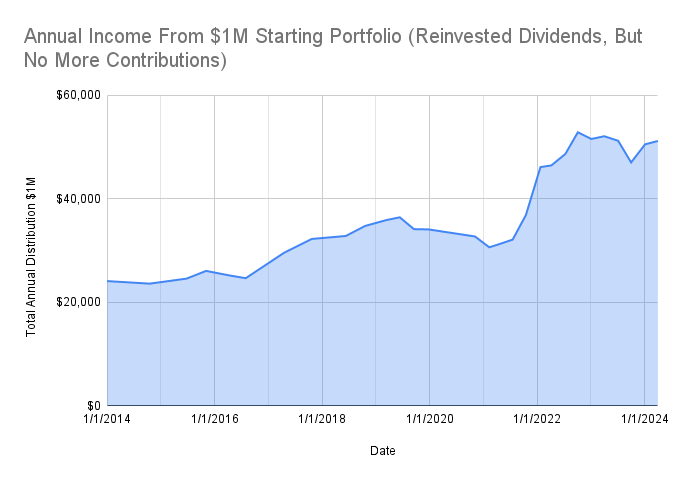
At any given time, this is a pretty arbitrary number. But over a long period, I find it a much more pleasant way to track my progress.
TTM income yield. To estimate the income from my portfolio, I use the weighted “TTM” or “12-Month Yield” from Morningstar (checked 3/31/24), which is the sum of the trailing 12 months of interest and dividend payments divided by the last month’s ending share price (NAV) plus any capital gains distributed (usually zero for index funds) over the same period. My ttm portfolio yield is now roughly 2.53%.
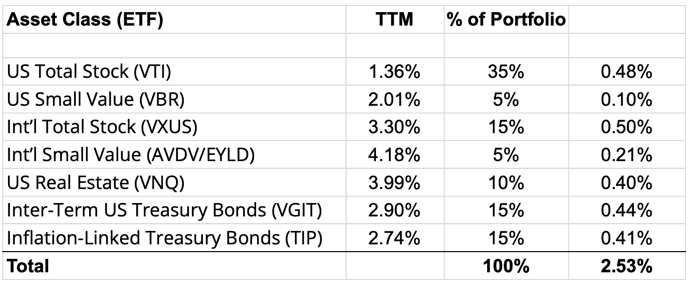
What about the 4% rule? For big-picture purposes, I support the simple 4% or 3% rule of thumb, which equates to a target of accumulating roughly 25 to 33 times your annual expenses. I would lean towards a 3% withdrawal rate if you want to retire young (closer to age 50) and a 4% withdrawal rate if retiring at a more traditional age (closer to 65). Too much time is spent debating this number. It’s just a quick and dirty target to get you started, not a number sent down from the heavens!
During the accumulation stage, your time is better spent focusing on earning potential via better career moves, improving in your skillset, and/or looking for asymmetrical entrepreneurial opportunities where you have an ownership interest.
As a semi-retired investor that has been partially supported by portfolio income for a while, I find that tracking income makes more tangible sense in my mind. Our dividends and interest income are not automatically reinvested. They are simply another “paycheck”. As with our other variable paychecks, we can choose to either spend it or invest it again to compound things more quickly. You could use this money to cut back working hours, pursue a different career path, start a new business, take a sabbatical, perform charity or volunteer work, and so on.
Working less helps me be a better parent. (I need all the help I can get.) I am consciously choosing to work when they are at school but also consciously turning down work that doesn’t fit my priorities and goals. This portfolio income helps me do that.
 The Best Credit Card Bonus Offers – 2025
The Best Credit Card Bonus Offers – 2025 Big List of Free Stocks from Brokerage Apps
Big List of Free Stocks from Brokerage Apps Best Interest Rates on Cash - 2025
Best Interest Rates on Cash - 2025 Free Credit Scores x 3 + Free Credit Monitoring
Free Credit Scores x 3 + Free Credit Monitoring Best No Fee 0% APR Balance Transfer Offers
Best No Fee 0% APR Balance Transfer Offers Little-Known Cellular Data Plans That Can Save Big Money
Little-Known Cellular Data Plans That Can Save Big Money How To Haggle Your Cable or Direct TV Bill
How To Haggle Your Cable or Direct TV Bill Big List of Free Consumer Data Reports (Credit, Rent, Work)
Big List of Free Consumer Data Reports (Credit, Rent, Work)
Seems weird to plot out dividend growth without accounting for inflation.
Inflation is certainly important to consider, but do you know of an easy way to account for inflation? I’m afraid that’s way too much work to do so manually.
The easy way to do it for two points in time is to use the BLS CPI Inflation Calculator: https://www.bls.gov/data/inflation_calculator.htm
So for your “My portfolio income history” section you could include the fact that accounting for CPI, $24k in Jan 2014 is $31.6k in Jan 2024. To make it more interpretable, I would report the percent increase beyond inflation for your two scenarios.
I don’t know of the easiest way to plot inflation-corrected dividends over time. But it wouldn’t be too hard to download the monthly CPI data and use it to normalize a plot. https://data.bls.gov/timeseries/CUUR0000SA0
CPI isn’t perfect, but it’s better than nothing.
Yeah, that sounds entirely reasonable. I’m probably still too lazy though. It’s just a quarterly check-in for me; I don’t adjust my internal net worth updates for inflation either.
Jonathan, thank you for this post. Is it correct that this portfolio is all held in taxable accounts? In other words, this does not include any interest / dividends being generated in your retirement accounts.
All accounts are included, both taxable and tax-deferred retirement accounts. I may not be able to withdraw from retirement accounts right now, but I don’t withdraw enough right now to require all of the dividends and interest. I could also rebalance within the retirement accounts without any tax hit and simply spend some bonds/cash from taxable.
I’m assuming you also have blog revenue?
Yes, we both still have income-producing work and projects, although it is no longer enough to cover all our expenses. We may still contributed to IRAs and 401ks to take advantage of tax-deferred opportunities, but we also spend down the taxable dividends that we receive. As noted, this is why we don’t automatically reinvest dividends.